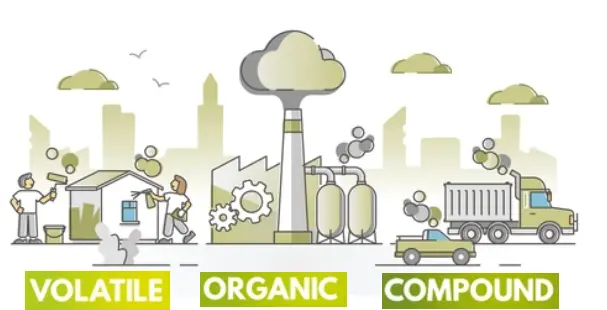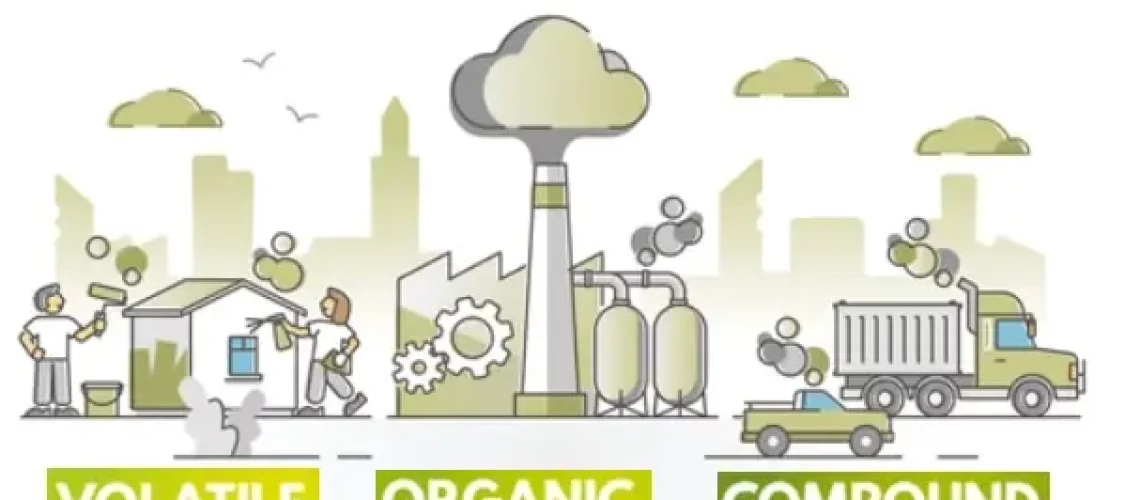Volatile organic compounds (VOCs) are a group of organic chemicals that have high vapour pressure and low water solubility at room temperature. The high vapour pressure of VOCs results due to a low boiling point, which allows their molecules to evaporate from liquid to gas phase quickly. VOCs are found in a wide range of products and materials, including fossil fuels, solvents, cleaning agents, adhesives, paints, and many others.
Exposure to VOCs can have negative health effects, particularly when they are present in high concentrations or for long periods of time. Due to their potential health and environmental impacts, many governments have regulations in place to limit the amount of VOCs that can be used in certain products or processes. In addition, there are many low-VOC or zero-VOC products available on the market, which can help to reduce exposure to these harmful chemicals.
Sources of Volatile Organic Compounds
Petroleum & Petrochemical Industry
The petroleum industry is a major source of volatile organic compounds (VOCs), which are emitted during the production, transportation, and refining of petroleum products. Some of the main sources of VOCs in the petroleum industry include:
- Oil and Gas Production: VOCs can be released during the extraction, drilling, and transportation of crude oil and natural gas. This can occur due to leaks or evaporation from open tanks or pipelines.
- Refining Processes: VOCs can be emitted during the refining of crude oil into various petroleum products such as gasoline, diesel, and jet fuel. These emissions can occur during distillation, cracking, and other refining processes.
- Storage and Transportation: VOCs can be released during the storage and transportation of petroleum products, particularly if they are stored in open tanks or transported in poorly sealed containers.
- Flaring and Heating: Flaring and heating are common practices in the petroleum industry that can release significant amounts of VOCs into the atmosphere. Flaring is the burning of gases that are not suitable for use, while venting involves the release of gases directly into the atmosphere. Various process heaters are applied in refineries for heating the process streams, these heaters use refinery fuel oil or fuel gas which are also sources of VOCs.
- Waste Disposal: Waste products from the petroleum industry, such as drilling muds and sludges, can also contain VOCs that can be released into the environment during disposal.
- Chemicals Manufacturing: VOCs can be emitted during the production of chemicals such as ethylene, propylene, benzene, toluene, and xylene. These chemicals are commonly used as feedstocks in the production of a wide range of products, including plastics, rubber, and textiles.
Other industrial sources of VOCs include;
- Paints and coatings: Solvents used in paints and coatings can emit VOCs.
- Consumer products: Household products such as cleaning agents, air fresheners, and personal care products can contain VOCs.
- Transportation: VOCs can be emitted from vehicles, including cars, trucks, and airplanes, as well as from fuel storage and handling facilities.
- Waste disposal: Landfills and other waste management facilities can emit VOCs from the decomposition of organic materials.
- The industrial sectors considered are printing (letterpress, offset and gravure printing processes), wood furniture coating, shoemaking, paint manufacturing and metal surface coating.

Health Effects of Volatile Organic Compounds
Exposure to volatile organic compounds (VOCs) can have negative health effects, particularly when they are present in high concentrations or for long periods of time. Some of the potential health effects of VOC exposure include:
- Eye, nose, and throat irritation: VOCs can cause irritation and inflammation of the eyes, nose, and throat, which can lead to symptoms like redness, itching, burning, and soreness.
- Headaches and dizziness: Exposure to VOCs can also cause headaches, dizziness, and lightheadedness, which can be particularly problematic for people who are sensitive to these chemicals.
- Respiratory problems: Prolonged exposure to VOCs can cause respiratory problems, such as coughing, wheezing, and shortness of breath. People with pre-existing respiratory conditions like asthma may be especially susceptible to these effects.
- Damage to organs: Some VOCs have been linked to damage to the liver, kidneys, and central nervous system, particularly if exposure occurs over a long period of time.
- Cancer: Exposure to certain VOCs, such as benzene, formaldehyde, and vinyl chloride, has been linked to an increased risk of cancer.
Examples of Volatile Organic Compounds
Some of the major volatile organic compounds are as follows;
- Benzene: Benzene is a colourless liquid formed from both human-made activities and natural processes. Two natural sources of benzene are volcanoes and forest fires. Benzene is a natural part of crude oil, gasoline, and cigarette smoke. Emissions from burning coal and oil, benzene waste and storage operations, motor vehicle exhaust, and evaporation from gasoline service stations can cause benzene levels in the air to increase.
- Xylene: Xylene is mostly a human-made chemical. Chemical industries produce xylene from petroleum. Xylene also occurs naturally in petroleum and coal tar and is formed during forest fires. Xylene is used as a solvent and in the printing, rubber, and leather industries. It is used as a cleaning agent and a thinner for paint and varnishes.
- Toluene: Toluene is a clear, colourless liquid that occurs naturally in crude oil and in the tolu tree. It is produced in the process of making gasoline and other fuels from crude oil. Toluene is also used in making paints, paint thinners, fingernail polish, lacquers, adhesives, and rubber, and in some printing and leather tanning processes.
- Styrene: Styrene is mainly a human-made chemical used mostly to make rubber and plastics. Low levels of styrene occur naturally in a variety of foods such as fruits, vegetables, nuts, beverages, and meats. Styrene is also present in combustion products, such as cigarette smoke and automobile exhaust.
- Carbon tetrachloride: Carbon tetrachloride does not occur naturally. It has been produced in large quantities to make refrigeration fluid and propellants for aerosol cans. However, the production of carbon tetrachloride is being phased out. Carbon tetrachloride was also used in fire extinguishers and as a fumigant to kill insects in grain.
- Tetrachloroethylene: Tetrachloroethylene, also known as perchloroethylene, is a human-made chemical that is widely used for the dry cleaning of fabrics and for metal-degreasing operations. It is also used as a starting material (building block) for making other chemicals and is used in some consumer products such as water repellents, silicone lubricants, fabric finishers, spot removers, adhesives, and wood cleaners.
- Trichloroethylene: Trichloroethylene is mainly used as a solvent to remove grease from metal parts and is found in some household products, including typewriter correction fluid, paint removers, adhesives, and spot removers.
- Formaldehyde: Found in building materials, such as insulation and particleboard, as well as some household products, like cleaning agents. It is also used as a biocide in some drilling fluids and can be emitted during its use.
- Ethylene Glycol: Found in antifreeze and some cleaning products.
- Acetone: Found in nail polish remover, some cleaning products, and as a solvent in some manufacturing processes.
- Methane: Methane is a VOC that is the primary component of natural gas. It is a potent greenhouse gas and is emitted during various oil and gas extraction and production processes.
- Ethylene: Ethylene is a VOC that is emitted during the production of natural gas and during the transport and storage of natural gas and crude oil. It is used to produce a wide range of plastics and other petrochemical products.
- Butadiene: Butadiene is a VOC that is emitted during the production of natural gas and during the refining of crude oil.
- Propylene: Propylene is a VOC that is produced during the refining of crude oil and is also used to produce plastics and other petrochemical products.
- Methanol: Methanol is a VOC that is used as a feedstock for the production of formaldehyde, acetic acid, and other petrochemical product
Control measures to reduce VOCs
There are various controls that can be implemented to reduce volatile organic compounds (VOCs) emissions in different industries, including the petroleum, oil and gas, and petrochemical industries. Here are some examples:
- Use of low-VOC or zero-VOC products: Using products that have lower VOC content or do not contain VOCs can reduce emissions. This can include using low-VOC paints and coatings, adhesives, and sealants.
- Implementing emissions control technologies: Installing and using equipment to capture and control emissions can be an effective way to reduce VOC emissions. Examples of emissions control technologies include vapor recovery units (VRUs), flare gas recovery systems, and catalytic oxidizers.
- Improving storage and transport systems: Properly maintaining and upgrading storage tanks and pipelines can reduce VOC emissions from leaks and evaporation. Implementing measures to reduce emissions during loading and unloading operations can also be effective.
- Process modifications: Changing production processes to reduce VOC emissions can be effective, such as reducing the use of solvents, optimizing combustion processes, and using alternative feedstocks.
- Regulatory controls: Government regulations can set limits on VOC emissions and require companies to implement controls to reduce emissions. This can include permitting requirements, emissions reporting, and compliance monitoring





